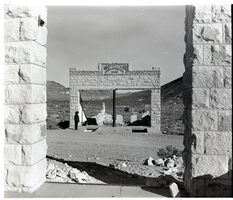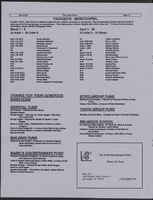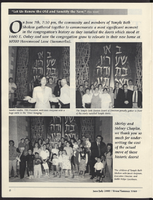Search the Special Collections and Archives Portal
Search Results
Jeff Gale Photographs
Identifier
Abstract
The Jeff Gale Photographs (approximately 1992-2001) primarily contain aerial images of the Las Vegas Strip taken from the Stratosphere Tower and other locations around the city that were shot by Las Vegas, Nevada photographer Jeff Gale. Materials include images of the Sam's Town 300 NASCAR race at the Las Vegas Motor Speedway as well as images of the Hoover Dam and Lake Mead Recreation Area. The collection also includes what may be personal family photographs taken around various locations around southern Nevada and the southwest region.
Archival Collection
University of Nevada, Las Vegas Arboretum Project Records
Identifier
Abstract
The University of Nevada, Las Vegas Arboretum Project Records are comprised of documents, brochures, and photographs dating from 1976 to 2012 documenting both the creation and operations of the Arboretum at the University of Nevada, Las Vegas (UNLV). The collection includes photographs of planning the Arboretum, the opening ceremony, and aerial photos of the UNLV campus. The brochures include guides to the Arboretum, lists of types of plants grown, and information on the Xeric Garden.
Archival Collection
University of Nevada, Las Vegas Office of Decision Support Records
Identifier
Abstract
The University of Nevada, Las Vegas Office of Decision Support Records (approximately 1960-2006) consist primarily of financial documents, correspondence, projections, budgets, and audit reports pertaining to the University of Nevada, Las Vegas (UNLV) Board of Regents, the UNLV Faculty Senate, and the University and Community College System of Nevada (UCCSN). The collection also includes information relating to accreditation, affirmative action, gender equality, and other initiatives at UNLV. This collection contains materials created by the Office of Institutional Planning and Analysis, which later became part of the Office of Decision Support.
Archival Collection
University of Nevada, Las Vegas Foundation Records
Identifier
Abstract
The University of Nevada, Las Vegas (UNLV) Foundation Records (1981-2013) primarily contain photographs, slides, negatives, and proof sheets from Foundation events, fundraisers, and projects. The collection also contains VHS copies of interviews and newscasts pertaining to the UNLV Foundation, annual dinner programs and invitations, and various publications created by the Foundation. The UNLV Foundation is located on the UNLV campus in Las Vegas, Nevada and is a nonprofit organization that seeks and manages gifts to the University of Nevada, Las Vegas.
Archival Collection
Frank Scott Papers
Identifier
Abstract
The Frank Scott Papers date from 1940 to 1984 and contain promotional materials, photographs, and menus from the Union Plaza Hotel; University of Nevada, Las Vegas (UNLV) basketball memorabilia; and KRLR TV documentation, correspondence, and news clippings. The collection also contains a scrapbook and photographs of the re-opening of the Mizpah Hotel in Tonopah, Nevada.
Archival Collection

Film transparency of the ruins of the H. D. and L. D. Porter Brothers Store, Rhyolite, Nevada, November 25, 1948
Date
Archival Collection
Description
Image




